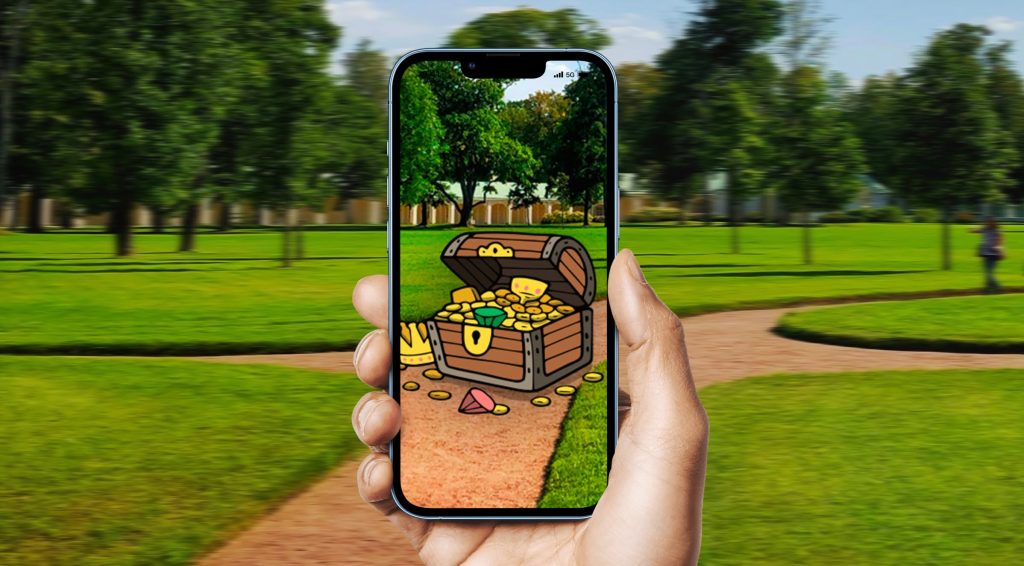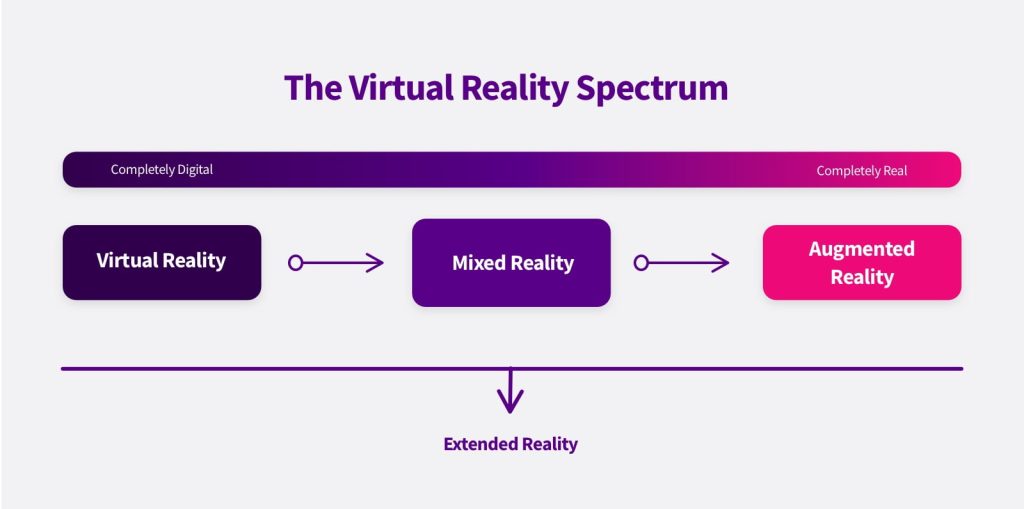AR vs VR: Differences between augmented reality and virtual reality
Contents
Augmented reality (AR) and virtual reality (VR) are two technologies that are related but at the same time very different. Both are used to create immersive experiences, but have significant differences in the way they work and the types of experiences they can provide.
The main difference between AR and VR is that the first adds virtual elements to the real world, while the second creates a completely new virtual world that users can immerse themselves in and explore.
In other words, virtual reality creates a completely immersive and artificial experience, while augmented reality adds digital information to the existing physical experience.
What is Augmented Reality?
Augmented reality is a technology that superimposes images, information and data generated by a device on the real world, allowing users to interact with virtual elements in a real environment.
It is a type of technology that allows us to add layers of digital and visual information in the real world, using the camera and screen of a device, such as a mobile phone, which is available to everyone. This means that the person is still in the real world, but can see additional information on the screen that is superimposed on the real environment.
For example, we can see a restaurant menu in augmented reality by focusing on the menu, or additional information that appears when we point the mobile camera at a work of art, or even play games such as a treasure hunt in any location.
In short, AR has multiple applications and always allows users to see additional information about their environment or interact with virtual objects in the real world based on the recognition of images, elements, surfaces or landscapes that after being scanned by the devices allow us to start AR experiences.
If you want to know more about this technology, we recommend that you read our specific post about what augmented reality is, where we explain it in more detail.


What is Virtual Reality?
Virtual reality, on the other hand, is a technology that uses display and motion tracking devices to immerse users in a fully simulated virtual environment. Users can interact with virtual objects and explore environments that do not exist in the real world. VR is often used in entertainment applications, such as video games and movies, as well as in training and simulation applications.
Virtual reality is a technology that creates a completely new, immersive and totally artificial environment that can be explored by a person through a device such as a headset, headphones or VR glasses. In this environment, the user can interact with virtual objects and other elements in a simulated experience that can be very different from physical reality.
What is extended reality?
Extended reality is a term used to refer to a set of technologies that combine elements of virtual reality, augmented reality and mixed reality to create more immersive and realistic interaction experiences.
Extended reality is a term used to refer to any experience that combines the real world with virtual elements in some way. It can be used on a variety of devices, from smartphones and tablets to augmented reality glasses and virtual reality headsets. Overall, extended reality has great potential to transform the way we interact with the world and can have applications in areas such as entertainment, education, medicine, industry and much more.
What is mixed reality?
In order to understand all these concepts, it is also necessary to mention mixed reality. This is a technology that combines elements of virtual reality and augmented reality to create a more immersive and realistic interaction experience. In mixed reality, virtual objects and the real world coexist and integrate with each other in real time.
Mixed reality uses devices such as headsets, glasses or screens to superimpose virtual objects on the real world. These objects can interact with the real world and with other virtual objects in the same scene, allowing for a more interactive and realistic experience.
An example of a mixed reality application would be a game where players can interact with virtual characters and objects in a real world. They can also be used in industry to create virtual prototypes of products and see how they would look in a realistic environment.


Differences between AR and VR
Augmented reality and virtual reality are two immersive technologies that have changed the way people interact with the world around us, but, as we have pointed out, they have many differences. Here are the main ones:
Features | Augmented Reality | Virtual Reality |
Definition | It superimposes digital and visual information on the real world. | It creates a completely new and artificial virtual environment. |
Devices used | Mainly mobile devices, screen, cameras, which makes it more accessible.It can also be consumed through AR glasses. | Always require devices such as VR glasses, VR headsets, motion tracking devices. |
Interaction | Interaction with the real world and virtual objects. | Interaction only with virtual objects in a virtual world. |
Cost | Less expensive technology. Fully affordable solutions can be obtained for any company and user. | It is a technology that requires a much higher investment. |
Applications | Advertising, marketing, gaming, education, navigation, medicine, construction, architecture, retail, industry, tourism, sports, events, culture, ecommerce… | Video games, training simulation, entertainment experiences, design and prototyping, psychotherapy, occupational therapy, among others. |
Visualisation and viralisation | It allows sharing the same experience with other users in the same physical space. | It does not allow sharing the same experience with other users in the same physical space. |
Comfortability | It can be used for longer periods without causing eyestrain or dizziness. | May cause eyestrain or dizziness after short periods of use. |
Limitations | It requires a well-illuminated environment to work correctly. | It requires a large and well-illuminated space to avoid collisions with physical objects. |
Level of immersion | It offers a level of partial immersion, meaning that the experience feels as if the virtual objects are superimposed on the real world. | It offers a level of total immersion, meaning that the experience feels as if the user is inside a completely new virtual world. |
Learning | It can be more intuitive for users, as it is based on real-world objects and relevant information is overlaid. | It can have a steeper learning curve, as users must learn to navigate and manipulate objects in a new virtual environment. |
Accessibility | It is much more accessible because nowadays everyone has a mobile phone with which to consume an AR experience. | As different specific devices are required, it is less accessible to all users. |
Advantages and disadvantages of Augmented Reality
Advantages:
- Improves user experience. Augmented reality allows users to interact with virtual objects in a real environment, improving the user experience.
- Increases efficiency, as it can help to increase efficiency in a wide variety of sectors such as industry, medicine, construction, tourism, education, advertising, marketing, entertainment, retail, etc., by providing real-time information.
- It reduces costs in the production of products and services by allowing users to see how they will look and work before they are mass-produced.
- Facilitates learning and makes it more interactive and engaging by allowing users to interact with virtual objects in a real environment.
- It creates new business opportunities. Augmented reality can be an effective marketing tool, allowing companies to create interactive and engaging advertising campaigns. It also facilitates the visualisation of products and services, which can, among other benefits, increase a company’s sales.
Disadvantages:
- It requires specific hardware. To experience augmented reality, users need a compatible device, such as a smartphone or tablet, which may limit its use, although it is true that it is more accessible than other technologies as it can be consumed simply with a mobile phone, without the need for other specific devices.
- It may cause dizziness or nausea in some people, especially if used for long periods of time.
- The accuracy of the overlay of virtual elements may be limited depending on the capabilities of the device used.
- Creating high quality augmented reality experiences can be expensive, which may limit their use for smaller companies. At Onirix this is one of the barriers we overcome with our no-code / low-code platform, as anyone can create a professional augmented reality experience without the need for technical knowledge or high investment.
If you want to create AR experiences in a professional way without a high investment and the need for technical knowledge, we invite you to register and try our Free Plan. Check out all the advantages that augmented reality offers for your customers or for your business and see the accessibility of Onirix.
In addition, you can create experiences from scratch and customise and adapt them to a brand or, if you prefer, you have available our Experience Library where you have at your disposal templates and replicable examples of different levels and features.
Advantages and disadvantages of Virtual Reality
Advantages:
- Virtual reality offers an immersive experience that can transport users into virtual environments and make them feel as if they are physically there, which would otherwise not be possible.
- It can be accessible to anyone as long as they have a compatible device, which means it can be used by people with disabilities or physical limitations.
- It has great utility in training and education programmes to simulate real-world scenarios and allow students to practice complex situations in a safe and controlled way.
- It also offers entertainment experiences, such as games and simulations, which can be more immersive and exciting than traditional entertainment media.
- It can save time and costs by allowing people to interact with virtual environments instead of travelling or building physical prototypes.
Disadvantages:
- Requires expensive devices and advanced technology to function correctly.
- Can cause eyestrain, dizziness and nausea in some users.
- May be less effective for teaching practical skills that require real physical interaction.
- Can limit social interaction by being isolated in a virtual world.
- Control difficulties. Some users may have difficulty in controlling their movements in the virtual environment, which can make the experience uncomfortable or frustrating.
- It may be less immersive than real reality in terms of visual quality and detail.
- Risk of addiction: As with any form of entertainment, virtual reality has the risk of being addictive, which can interfere with the user’s daily life.
Applications and examples
Augmented reality is a technology that allows digital information to be overlaid on the real world in real time, creating a combined experience of physical and virtual reality. As we have seen, it has a multitude of applications and can offer solutions in multiple sectors. Here are just a few of them.
- Advertising and marketing: Augmented reality is often used in advertising and marketing campaigns to create interactive and immersive experiences for consumers. For example, making an interactive video game for the launch of a new product to collect customer data, as the well-known hamburger brand Goiko did for the promotion of a new product.
- Ecommerce and retail: A company can use augmented reality to allow customers to see what a product would look like before they buy it and improve the user experience while reducing returns.
- Tourism and culture: provides real-time information about attractions, historical and cultural places. For example, tourists can use AR in a museum to get additional information about a work of art by pointing their camera at it.
- Education: Augmented reality can be used in the classroom to improve student learning. For example, teachers can use AR to show three-dimensional models of objects or animals that students can examine from all angles.
- Medicine: to improve accuracy in surgery, physician training and patient education. Doctors can use augmented reality to overlay vital patient information, such as diagnostic images or process details, in real time to get a better understanding of the patient and improve results.
- Architecture, construction and design: Augmented reality is used in architecture and design to help professionals to visualise how a building or product would look in the real world before it is built. For example, architects can use augmented reality to create a virtual model of the building on the construction site and visualise how it would integrate with the surrounding environment.
Virtual reality is a technology that creates a 3D simulated environment that can be experienced by the user through a display device. Here are some applications of virtual reality:
- Training and education: Virtual reality is often used in training and education programmes to simulate real-world situations and allow students to practice difficult situations in a safe and controlled way. For example, medical students can use virtual reality to practice surgical interventions without the risk of harming a real patient.
- Entertainment: VR can be used to create more immersive and exciting entertainment experiences, such as games, movies, concerts and other forms of entertainment. For example, virtual reality video games can transport the player into a virtual world and allow them to interact with it in a more realistic and exciting way.
- Therapy: It is used in therapy to treat mental and physical disorders. For example, virtual exposure therapy can help people overcome phobias or anxieties by exposing them to situations they fear in a controlled way.
- Virtual tourism: Virtual reality is used in tourism applications to provide immersive experiences of remote or dangerous places. For example, a person can use virtual reality to explore a remote city or visit dangerous places without taking real risks.
- Exercise: Virtual reality is used in fitness applications to provide immersive and motivating workout experiences. For example, a person can use virtual reality to do exercises in a virtual environment and motivate him or herself to continue with the exercises.
Market size & Future
Both augmented reality and virtual reality are emerging technologies with great potential and growing demand in the market, which has experienced significant growth in recent years and is expected to continue to grow in the future.
According to a report by MarketsandMarkets, the AR and VR market is expected to reach $117.4 billion by 2026, with a compound annual growth rate of 34.1% between 2021 and 2026. According to the same source, the augmented reality market specifically is expected to reach $55.8 billion by 2025, with a compound annual growth rate of 40.29% between 2020 and 2025.
Augmented reality and virtual reality are increasingly being used across a wide range of industries and sectors, as we have already seen, to improve the user experience and provide a more immersive way of interacting with the digital world. In addition, the COVID-19 pandemic has also accelerated the adoption of these two technologies as many businesses have been forced to adapt to the new normal and find ways to connect with their customers remotely.
In short, new technologies and devices are expected to continue to be developed to improve the user experience and are also expected to be increasingly integrated into everyday life, which will change the way people consume content and interact with the digital and physical world.



